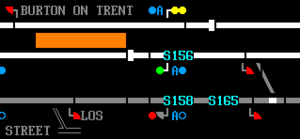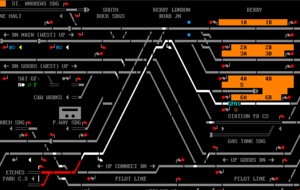SimSig:Berth: Difference between revisions
m Jarley moved page SimSig/berth to SimSig:Berth without leaving a redirect |
m fix links |
||
| Line 1: | Line 1: | ||
A berth is a space on a signaller's panel where a [[SimSig | A berth is a space on a signaller's panel where a [[SimSig:Train Description|Train Description]] can be shown. This is usually, but not always, next to a signal. | ||
Back in the old days when railways ran on relays and signalling cables weighed more than the track, these were often miniature cathode-ray tubes mounted behind an [[SimSig | Back in the old days when railways ran on relays and signalling cables weighed more than the track, these were often miniature cathode-ray tubes mounted behind an [[SimSig:NX panel|NX panel]], with huge racks of complex electronics to store and move and draw the four alphanumeric characters on each one. In more recent installations, LED matrices were used instead, but there was still a substantial cost involved in providing and maintaining them and the control circuitry which drives them. | ||
What's not obvious to new players is that SimSig (and the real software panels it emulates) has the same constraint. Berths exist in specific locations chosen by signalling engineers in a way that can seem arbitrary and inconsistent. But unlike a physical panel, in SimSig an empty berth is invisible, so learning where all the berths are can be a matter of trial and error. | What's not obvious to new players is that SimSig (and the real software panels it emulates) has the same constraint. Berths exist in specific locations chosen by signalling engineers in a way that can seem arbitrary and inconsistent. But unlike a physical panel, in SimSig an empty berth is invisible, so learning where all the berths are can be a matter of trial and error. | ||
Latest revision as of 00:32, 15 February 2021
A berth is a space on a signaller's panel where a Train Description can be shown. This is usually, but not always, next to a signal.
Back in the old days when railways ran on relays and signalling cables weighed more than the track, these were often miniature cathode-ray tubes mounted behind an NX panel, with huge racks of complex electronics to store and move and draw the four alphanumeric characters on each one. In more recent installations, LED matrices were used instead, but there was still a substantial cost involved in providing and maintaining them and the control circuitry which drives them.
What's not obvious to new players is that SimSig (and the real software panels it emulates) has the same constraint. Berths exist in specific locations chosen by signalling engineers in a way that can seem arbitrary and inconsistent. But unlike a physical panel, in SimSig an empty berth is invisible, so learning where all the berths are can be a matter of trial and error.

You will usually be able to interpose a Train Description (TD) on any main (non-shunting) signal, though exceptions exist. Sometimes a berth will be shared between two signals facing in opposite directions - sometimes each signal gets its own berth.
Likewise, although you're less likely to find a berth on a shunting signal, they often do have them. If you signal a train into a siding or loop with no TD berths, you'll need to keep a note of the TD elsewhere, such as on a sticky note.
Signallers can manually interpose a TD into most berths, or cancel a TD to clear the berth. Some berths cannot be interposed into - for instance the "Approaching" and "Last sent" berths, which are updated automatically.
TDs move from berth to berth across the panel following the movement of the trains they describe. This movement is actually driven by track circuits becoming occupied. Track circuit failures, trains going in the wrong direction, trains splitting and joining, and other complex movements, can all result in erratic behaviour requiring careful babysitting.

Where a train enters from another signalbox, usually there's provision for the TD to arrive on your panel automatically. Where a train enters from a yard or depot, it depends. If you're lucky, the TD will appear in a suitable berth automatically. If you're less lucky, the dispatcher will phone up and give you the TD and you'll interpose it immediately into the signal the train enters from. If you're unlucky, you'll have to make a note of the TD and the departure point, signal the train in, and interpose its TD at a signal some distance from where it arrived.
